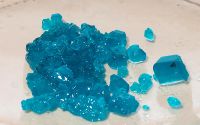Difference between revisions of "Nickel(II) sulfate"
m (added photo.) |
|||
| Line 109: | Line 109: | ||
}} | }} | ||
'''Nickel(II) sulfate''' is inorganic salt of [[nickel]] with formula '''NiSO<sub>4</sub>'''. Nickel sulfate has many forms, anhydride, hexahydrate and heptahydrate.In nature occurs as rare mineral retgersite (hexahydrate) or morenosite (heptahydrate). | '''Nickel(II) sulfate''' is inorganic salt of [[nickel]] with formula '''NiSO<sub>4</sub>'''. Nickel sulfate has many forms, anhydride, hexahydrate and heptahydrate.In nature occurs as rare mineral retgersite (hexahydrate) or morenosite (heptahydrate). | ||
| + | |||
==Properties== | ==Properties== | ||
| − | Nickel | + | Nickel sulfate is a yellow, green or blue colored, crystalline inorganic compound that produces toxic gases upon heating. Nickel sulfate is used in electroplating and as a chemical intermediate to produce other nickel compounds. |
| + | |||
Anhydrous nickel sulfate is a yellow-green crystalline solid. Nickel sulfate can also be obtained as a hexahydrate which is blue to emerald green, and as a heptahydrate (NiSO4.7H2O), which is green. Samples can contain variable quantities of water, depending on their previous exposure to moisture or conditions. All forms are mildly toxic and are carcinogenic. All are denser than water. | Anhydrous nickel sulfate is a yellow-green crystalline solid. Nickel sulfate can also be obtained as a hexahydrate which is blue to emerald green, and as a heptahydrate (NiSO4.7H2O), which is green. Samples can contain variable quantities of water, depending on their previous exposure to moisture or conditions. All forms are mildly toxic and are carcinogenic. All are denser than water. | ||
| − | |||
==Availability== | ==Availability== | ||
| − | Nickel(II) sulfate is sold | + | Nickel(II) sulfate is sold by many chemical suppliers. |
==Preparation== | ==Preparation== | ||
| − | Nickel sulfate can be made by reacting [[nickel hydroxide]] or | + | Nickel sulfate can be made by reacting [[nickel hydroxide]] or nickel powder with [[sulfuric acid]]. |
==Projects== | ==Projects== | ||
*Growing crystals | *Growing crystals | ||
| + | *Nickel plating | ||
==Handling== | ==Handling== | ||
===Safety=== | ===Safety=== | ||
Exposure to this substance can cause severe dermatitis, skin and asthma-like allergies and affects the lungs, kidneys, gastrointestinal tract and neurological system. Nickel sulfate is a known carcinogen and is associated with an increased risk of developing lung and nasal cancers. | Exposure to this substance can cause severe dermatitis, skin and asthma-like allergies and affects the lungs, kidneys, gastrointestinal tract and neurological system. Nickel sulfate is a known carcinogen and is associated with an increased risk of developing lung and nasal cancers. | ||
| + | |||
===Storage=== | ===Storage=== | ||
| − | + | Nickel(II) sulfate is best stored in closed bottles. | |
===Disposal=== | ===Disposal=== | ||
Nickel(II) sulfate should be reduced to an insoluble form and taken to disposal centers. | Nickel(II) sulfate should be reduced to an insoluble form and taken to disposal centers. | ||
The primary hazard is the threat to the environment. Immediate steps should be taken to limit its spread to the environment. | The primary hazard is the threat to the environment. Immediate steps should be taken to limit its spread to the environment. | ||
| + | |||
==References== | ==References== | ||
<references/> | <references/> | ||
===Relevant Sciencemadness threads=== | ===Relevant Sciencemadness threads=== | ||
| + | *[http://www.sciencemadness.org/talk/viewthread.php?tid=14242 nickel sulfate] | ||
[[Category:Chemical compounds]] | [[Category:Chemical compounds]] | ||
Revision as of 18:54, 7 September 2016
 |
This article is a stub. Please help Sciencemadness Wiki by expanding it, adding pictures, and improving existing text.
|

| |
| Names | |
|---|---|
| IUPAC name
Nickel(II) sulfate
| |
| Systematic IUPAC name
Nickel(II) sulfate | |
| Other names
Niccolum Sulfuricum
Nickelous sulfate Nickel sulphate | |
| Properties | |
| NiSO4 | |
| Appearance | yellow solid (anhydride) blue crystals (hexahydrate) blue-green crystals (heptahydrate) |
| Except where otherwise noted, data are given for materials in their standard state (at 25 °C [77 °F], 100 kPa). | |
| Infobox references | |
Nickel(II) sulfate is inorganic salt of nickel with formula NiSO4. Nickel sulfate has many forms, anhydride, hexahydrate and heptahydrate.In nature occurs as rare mineral retgersite (hexahydrate) or morenosite (heptahydrate).
Contents
Properties
Nickel sulfate is a yellow, green or blue colored, crystalline inorganic compound that produces toxic gases upon heating. Nickel sulfate is used in electroplating and as a chemical intermediate to produce other nickel compounds.
Anhydrous nickel sulfate is a yellow-green crystalline solid. Nickel sulfate can also be obtained as a hexahydrate which is blue to emerald green, and as a heptahydrate (NiSO4.7H2O), which is green. Samples can contain variable quantities of water, depending on their previous exposure to moisture or conditions. All forms are mildly toxic and are carcinogenic. All are denser than water.
Availability
Nickel(II) sulfate is sold by many chemical suppliers.
Preparation
Nickel sulfate can be made by reacting nickel hydroxide or nickel powder with sulfuric acid.
Projects
- Growing crystals
- Nickel plating
Handling
Safety
Exposure to this substance can cause severe dermatitis, skin and asthma-like allergies and affects the lungs, kidneys, gastrointestinal tract and neurological system. Nickel sulfate is a known carcinogen and is associated with an increased risk of developing lung and nasal cancers.
Storage
Nickel(II) sulfate is best stored in closed bottles.
Disposal
Nickel(II) sulfate should be reduced to an insoluble form and taken to disposal centers. The primary hazard is the threat to the environment. Immediate steps should be taken to limit its spread to the environment.